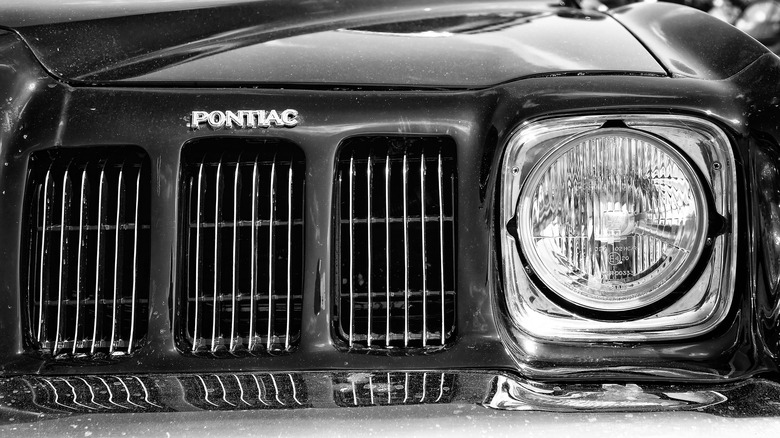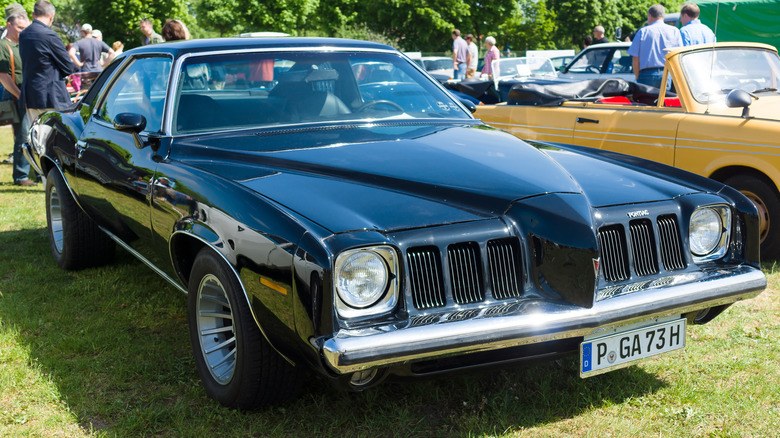
Sergey Kohl/Shutterstock
By the time that the mid-1970s rolled around, America’s muscle car heyday was already a memory. While the Clean Air Act — passed in 1970 – was one reason for the decline in powerful American cars, the straw that broke the camel’s back was the 1973 oil crisis, which caused mass fuel shortages and price spikes throughout the country — not a great time to own a heavy, gas-guzzling V8 muscle car.
Advertisement
In 1970, Pontiac was General Motors’ performance brand, using the slogan «We take the fun of driving seriously» to hammer the point home. However, with the muscle car formula dying — a segment that Pontiac is credited for inventing with the legendary GTO in 1964 — GM’s sport-oriented division needed to pivot to a different idea. Pontiac initially attempted to appeal to the luxury market in 1969 with the Grand Prix, which sold well, but Pontiac saw an opportunity for a bit of experimentation. They figured that if they took the luxury elements from the Grand Prix and mashed them with sporty elements from the Trans Am, they’d have a model for a large but unexplored market. That model became the Grand Am.
Advertisement
The Grand Am’s first and second generations are the only ones that truly followed that recipe. From 1973 to 1980, the Grand Am had varying levels of success merging the luxury and sports segments with moderate to poor sales figures over the years. In 1985, the Grand Am was completely rebranded into a front-wheel-drive compact, and it remained as such for the remainder of its third, fourth, and fifth generations. While the Grand Am started as an ambitious project by Pontiac, the later iterations were largely forgotten to time. Their resale values reflect that, too.
Third Generation Pontiac Grand Am (1985-1991) – $1,025
The third-generation Pontiac Grand Am was a massive identity shift for the nameplate — perhaps the biggest identity change of the model’s turbulent history. While the first and second-generation Grand Ams were built on the rear-wheel-drive A-platform, Pontiac decided to turn the third generation into a front-wheel-drive compact. That was the best decision Pontiac ever made for the Grand Am.
Advertisement
In lieu of using A-body underpinnings, the 1985-1991 Pontiac Grand Am was built on the front-wheel-drive GM N-body platform, which replaced the ill-fated and dangerous X-body platform that landed GM in hot water over safety concerns in the early 1980s. The third-generation Grand Am shared the platform with the Buick Regal Somerset and the Oldsmobile Calais. Despite being built on an aging front-wheel-drive platform and using the notoriously disappointing 90-horsepower Iron Duke four-cylinder engine as its base engine, the Grand Am was still marketed as a sporty car. While the initial car’s thin veneer of sportiness was pretty much only bolstered by a retro-futuristic speedometer and wrap-around side molding, the SE model, released in 1986, brought a bit more to the table with a 125 horsepower 3.0L V6. With the added power, the late model 1991 Grand Am is actually a much cooler car than most people remember it being.
Advertisement
Despite being somewhat of a sheep in wolf’s clothing, the third-generation Grand Am was a huge sales success, selling 200,000 units a year between 1986 and 1989. While there were millions on the streets in the late 1980s and early 1990s, third-generation Grand Ams are hard to come by these days. However, due to their relative mediocrity, even by 80s standards, their average value today is around $1,025 today.
[Featured image by Ryanandlenny via Wikimedia Commons | Cropped and scaled | CC BY-SA 3.0]
Fourth Generation Pontiac Grand Am (1992-1998) – $1,638
The fourth generation of the Pontiac Grand Am simply followed the footsteps of the third generation, with Pontiac adopting an «if it ain’t broke, don’t fix it» attitude towards the model. Since the previous generation sold so well, it remained a front-wheel-drive compact model on the GM N-platform, but received a styling refresh to bring the model more firmly into the 1990s. Many might argue that was a negative thing, as the fourth generation’s styling was divisive at best, with a massive front overhang and vaguely insect-like front facia.
Advertisement
Like the previous generation, the 1992-1998 Pontiac Grand Am shared the N-platform with its GM cousins, including the Buick Skylark and Oldsmobile Achieva. Also like the generation prior, all three were nearly identical under the surface. The fourth-gen Grand Am reverted in some ways and improved in others. For instance, while the third-generation Grand Am used four-wheel disc brakes, the fourth-gen used inferior drum brakes in the rear. However, the fourth-generation did receive some healthier engine options, including two V6 power plants, and other performance-enhancing attributes like ABS and a wider track width.
Like the previous generation Grand Am, the fourth generation sold like hotcakes in the United States. In fact, the fourth-gen was the highest-selling model of the Grand Am of them all, with over 200,000 units sold per year from 1992 until 1998, when the fifth-gen took its place. With so many fourth-generation Gran Am’s in circulation, you’d think that they would be everywhere. That isn’t the case, though, likely because many of them haven’t held up well to the elements over time. The ones that are still around typically go for between $1,700 and $2,000.
Advertisement
[Featured image by MercurySable99 via Wikimedia Commons | Cropped and scaled | CC BY-SA 4.0]
Fifth Generation Pontiac Grand Am (1999-2005) – $2,706
By the time the fifth generation Pontiac Grand Am rolled around in 1999, the N-body that it was built on had already been around for nearly 15 years. Because the Grand Am was selling so well as a front-wheel drive compact, Pontiac decided to carry on that recipe into the new millennium with the fifth generation. Pontiac also leaned very heavily into the Grand Am’s «sporty» reputation, especially with regard to its styling, which was just as controversial as many of the Grand Am generations that came before it.
Advertisement
While the fifth-generation Grand Am’s styling was polarizing, Pontiac made some attempts to improve the fifth-gen’s ageing underpinnings to match its exterior. 1999 was the first year that the Grand Am received entirely independent suspension, with a multilink setup in the rear and MacPherson struts in the front. Additionally, its body was stiffened by 32 percent, and its wheelbase was widened. The resulting Grand Am was a car that was more nimble in the corners and better at managing road imperfections — leading to better overall ride comfort. Its engine was also beefed up to a 3.4-liter V6 producing 170 horsepower in the GT model. The fifth generation Grand Am lasted until 2005, when the nameplate was retired for good.
Advertisement
Being the most recent Grand Am entry and selling well through its build cycle, the fifth-gen is the most likely to be seen on the road today. As a result, they are still easy to find on the used marketplace to this day, with a fair resale price of around $2,700 for one in good condition.
[Featured image by Elise240SX via Wikimedia Commons | Cropped and scaled | CC BY-SA 4.0]
Second Generation Pontiac Grand Am (1978-1980) – $5,825
After a three-year hiatus from 1975 to 1978, the Grand Am made a reappearance on Pontiac order sheets as a dramatically different car. In contrast to 1973-1975, the 1978-1980 Grand Am dropped all semblance of European finesse in favor of a more macho, muscle car-lite approach. Pontiac dropped the dramatic visual styling in favor of a more ’80s approach. The Grand Am was just a boxy Le Mans with a different grille, which didn’t make it stand out in any notable way. Not even the luxury interior accoutrements stayed from the first generation, with the Grand Am slipping back into mediocrity with cheaper wood paneling and a standard Pontiac dash.
Advertisement
Like the first generation, the second generation Grand Am was built on the A-body GM platform with few mechanical changes. It was, however, shorter, narrower, and lighter, which made its standard 140 horsepower 301 cubic-inch V8 feel a bit more potent. While underpowered by today’s standards, the second generation Grand Am’s real-world performance was respectable back then, even beating an Audi 5000 and BMW 630CSi around Road & Track’s slalom course in a 1978 test.
Since there wasn’t anything to make the Grand Am stand out compared to the cheaper and nearly identical-looking Le Mans, the market rejected it. Pontiac only sold 16,000 Grand Ams between 1978 and 1980, making it both a sales failure and a very rare car to see today. In fact, they’re so rare that they are extremely hard to find accurate resale values for since they don’t change hands very often. A recent example sold for $6,000 in Tacoma, Washington, and another well-maintained 1979 Grand Am sold for $7,500 in 2016.
Advertisement
[Featured image by Greg Gjerdingen via Wikimedia Commons | Cropped and scaled | CC BY-SA 2.0]
First Generation Pontiac Grand Am (1973-1975) – $30,000

Sergey Kohl/Shutterstock
The first-generation Pontiac Grand Am was a product of its time and the competition that surrounded it, which was ultimately a good thing. With American manufacturers focused squarely on optimizing efficiency and finding a niche outside of outright performance in the early 1970s, the Grand Am was truly an experiment for Pontiac more than anything else. In an effort to save cost, the first generation Grand Am was built on the GM A-body platform, which also served as the skeleton for the Buick Century, Chevrolet Chevelle, and the Oldsmobile Cutlass. Despite the similarities with the other A-bodies, Pontiac injected its own identity into the Grand Am, which helped it stand out in the pack.
Advertisement
When designing the first-generation Grand Am, Pontiac looked to Europe for ideas on how to blend performance and luxury into a single package. Key inspiration came from BMW, Mercedes, and Jaguar, which is evident in the Grand Am’s understated driver-oriented instrument cluster, mahogany accenting, and bucket seats. While European on the inside, the Grand Am was still all American on the outside, with what can only be said to be overstated styling that evokes a love-it-or-hate-it mentality. It wasn’t European under its skin either, using old suspension components from previous GM projects. While the luxury aspect was executed pretty well, performance wasn’t taken as seriously.
The first-generation Pontiac Grand Am has undoubtedly held up the best in terms of resale value compared to the other generations, largely because of its uniqueness and hints of pre-malaise-era character. While a good-condition 1973-1975 Grand Am fetches around $33,000 today, models equipped with either the optional 440 or 445 V8s can go for up to $60,000.
Advertisement